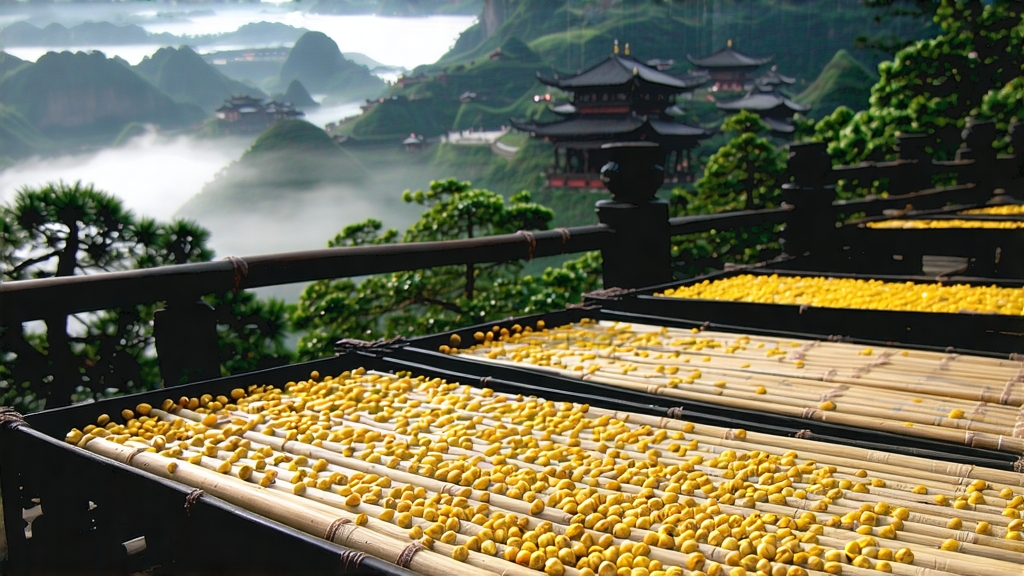
Tucked away in the cloud-veiled peaks of Sichuan’s Meng Ding mountain, 1,450 m above the Chengdu plain, grows a tea so discreet that even many Chinese millennials have never tasted it. Meng Ding Huang Ya—“Meng Ding Yellow Bud”—is the oldest documented yellow tea, yet it remains the least exported of China’s six great tea families. To understand it is to hold a living fragment of Tang-dynasty court life, a brew that once sailed the Min River in bamboo tubes sealed with beeswax, bound for Chang’an’s palace gates. Today only 300 mu (about 20 hectares) of state-protected gardens are authorised to bear the name, yielding scarcely 1.2 tonnes of finished tea each spring. The result is a liquor the colour of liquid topaz, a fragrance that drifts between fresh lilies and toasted pumpkin seeds, and a sweetness that arrives in waves, finishing with the cool minerality of mountain spring water.
Historical whispers
The first written record appears in the Meng Ding mountain gazette of 808 CE: “The monk Rong Zhao presents yellow bud to Emperor Xianzong; the cup glows like amber, the emperor smiles.” By the Song dynasty the tea had become an imperial tithe, collected by magistrates who sealed the harvest under wax and silk. When the Ming court shifted its taste to loose-leaf green teas, yellow tea fell out of fashion; by the late Qing the craft survived with only three hermit-monks who refused to let the skill die. Rediscovered in 1959 by the Sichuan Tea Research Institute, Meng Ding Huang Ya was re-established as a national cultural heritage item in 2008, its protocol enshrined in Bureau Standard GB/T 19698-2008.
Micro-terroir
Meng Ding enjoys a unique “three mist” climate: morning radiation fog, afternoon valley cloud, and evening drizzle carried by the Min River. The average annual humidity hovers at 88 %, slowing photosynthesis and concentrating amino acids—especially L-theanine, which reaches 4.2 %, double the level of most green teas. The garden soil is a crumbly quartz-porphyry granite rich in selenium and vanadium, elements that lend the tea its signature metallic snap on the finish. Only the local cultivar “Meng Ding #9” is permitted; its leaves are micro-serrated, 0.8 mm thick, and contain a rare flavonol—mengdioside—responsible for the subtle orchid note that appears after the third infusion.
Plucking ritual
Harvest begins on the first rain-free dawn after the spring equinox. Two leaves and a bud, no longer than 2.5 cm, are snapped sideways to avoid the fingernail’s oxidising oils. Pickers wear bamboo hats but no gloves—skin contact is believed to “read” the leaf’s moisture. The pluck must finish before 9 a.m.; any leaf picked after the mountain sun angle exceeds 45° is rejected because enzymatic activity rises too quickly for the delicate yellowing stage.
The secret of “sealed yellowing”
Unlike green tea, which is immediately pan-fired to kill-green, Meng Ding Huang Ya is lightly shaqing (120 °C for 90 s) only to deactivate 60 % of polyphenol oxidase. While still warm, the leaves are wrapped in thin linen pouches and stacked inside a pine-wood humidor kept at 34 °C and 78 % RH for 48 hours. During this “men huang” (sealed yellowing) phase, chlorophyll degrades into pheophytin, catechins dimerise into theaflavins, and a faint maillard reaction generates notes of sesame and custard. Every six hours the master opens the stacks, fluffs the leaves to release CO₂, then re-wraps with gradually looser tension—a choreography learned only by apprenticeship. The process is halted when the leaf edge turns golden and the central vein retains a jade stripe: the “gold-jade dichotomy” that judges prize.
Low-temperature rolling & firing
To preserve the yellow compounds, rolling is done at 28 °C on cool marble trays; pressure starts at 50 N and drops by 5 N every pass, preventing cell rupture that would darken the leaf. A two-stage firing follows: 65 °C for 40 min to reduce moisture to 18 %, then 45 °C for 3 hours to “fix” the yellow pigments. The